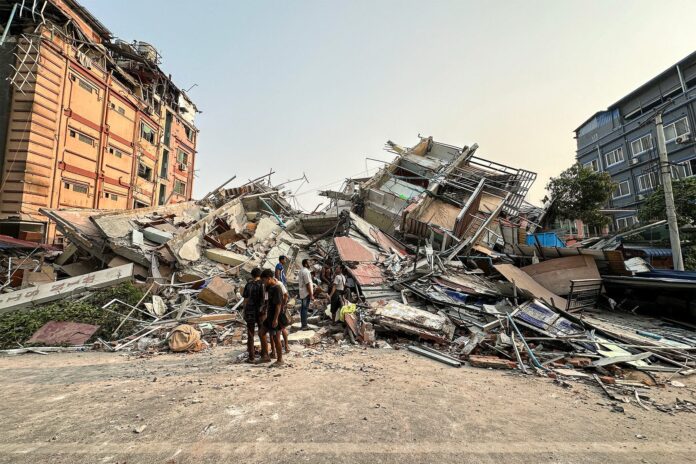A 7.7-magnitude earthquake struck central Myanmar today, wreaking havoc across a vast expanse of Southeast Asia. The quake — one of the three largest to hit the region in a century — gouged open roads, toppled century-old religious monuments, and destroyed numerous multistory buildings.
Rising Death Toll
The U.S. Geological Survey, which tracks seismic activity, estimated that the death toll is likely to surpass 10,000 people. A preliminary count from Myanmar’s military government reported at least 144 people killed and 732 injured across multiple cities. State-run MRTV confirmed these numbers, but the toll is expected to rise significantly.
Much of the devastation is concentrated in Mandalay, Myanmar’s second-largest city with approximately 1.5 million residents, which lies just 10 miles from the epicenter. A rescue worker from Amarapura, an ancient city now part of Mandalay, told Reuters that 30 bodies had been recovered from collapsed apartment buildings.
“I have never experienced anything like this before — our town looks like a collapsed city,” the worker said, estimating that about a fifth of the buildings had been destroyed.
Widespread Destruction
Photos and videos from the country show stunning scenes of destruction. The historic Ava Bridge over the Irrawaddy River partially collapsed, with its arches leaning into the water. Monks cried out as monastery buildings toppled over. Rescue workers are currently trying to reach dozens of monks trapped under rubble in the Phaya Taung Monastery.
In addition to Mandalay, state media reported the collapse of buildings in five cities and towns, as well as a railway bridge and a road bridge on the Yangon-Mandalay Expressway. In the capital Naypyidaw, a 1,000-bed hospital sustained damage and roads were left with huge fissures.
A Mandalay resident who witnessed a five-story building collapse said, “Everyone in my town is out on the road and no one dares to go back inside.” Another resident reported that destruction stretched across the whole city, and one neighborhood, Sein Pan, was on fire.
The quake’s impact extended well beyond Myanmar. In neighboring Thailand, a 33-story building under construction collapsed in Bangkok, more than 600 miles from the epicenter. Thai authorities confirmed at least nine fatalities there, with over 100 people reported missing as rescue operations continue.
International Response
General Min Aung Hlaing, leader of Myanmar’s military junta, acknowledged that casualties would rise and made an extraordinary plea for international assistance, inviting “any country” to provide help and donations.
Speaking at the White House, U.S. President Donald Trump said his administration would provide assistance. “We’re going to be helping,” he told reporters. The State Department spokesperson Tammy Bruce indicated that USAID disaster experts were ready to help with essentials like food and potable water, despite the administration’s recent push to cut the agency’s funding.
United Nations Secretary-General Antonio Guterres announced that the UN was mobilizing in Southeast Asia to provide aid, with initial relief funds set aside from the Central Emergency Response Fund.
Complicated Relief Efforts
The full extent of the devastation is difficult to assess in a country largely isolated from the rest of the world. Electricity and communication lines are down across affected regions.
Relief efforts are likely to be complicated by Myanmar’s ongoing political crisis. Since overthrowing the elected civilian government of Nobel laureate Aung San Suu Kyi in 2021, the military has struggled to maintain control. The junta is locked in a struggle with insurgents, and armed opposition groups have seized swathes of territory.
Zin Mar Aung, the diplomatic spokesperson for the opposition National Unity Government, said fighters from the anti-junta militias known as the People’s Defence Forces would provide humanitarian help.
Amnesty International noted that the earthquake “could not have come at a worse time for Myanmar,” given the number of displaced people, existing need for relief aid, and cuts to U.S. aid. The fighting has displaced more than three million people in Myanmar, with widespread food insecurity and over a third of the population already in need of humanitarian assistance, according to UN estimates.
Nyi Nyi Kyaw, a Myanmar academic at the University of Bristol, said Myanmar is “wholly unable to deal with the shock and its aftermath” due to the breakdown in civil society.
Myanmar lies on the boundary of two tectonic plates and is among the world’s most seismically active countries. The nation has faced multiple natural disasters in recent years, with the internationally isolated junta struggling to respond effectively.

